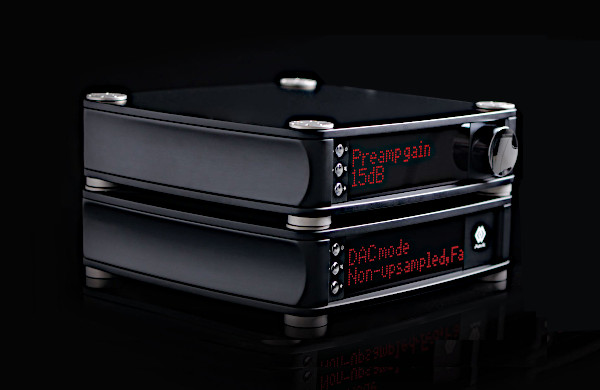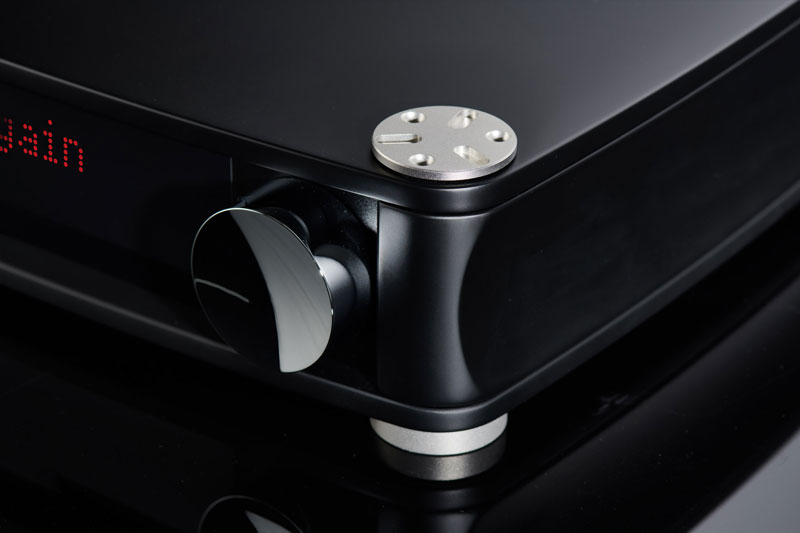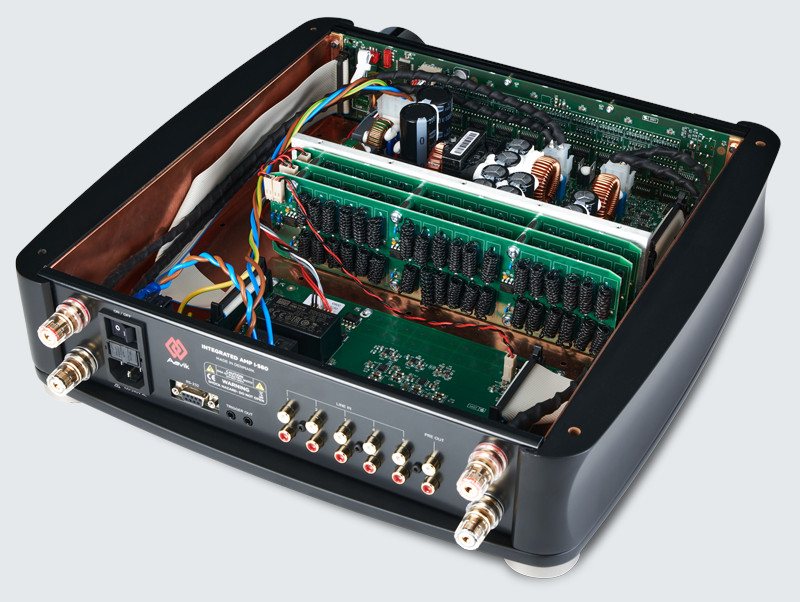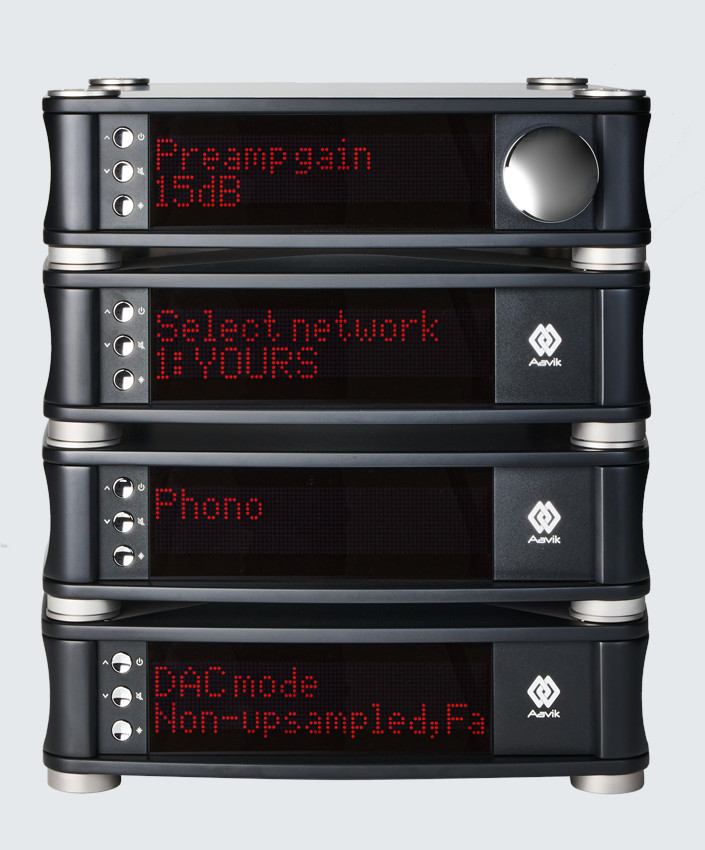AAVIK I-280
Integrated amplifiers
As far as its function is concerned the I-280 is an old-school integrated amplifier for audiophile purists. On the rear panel it has five single-ended RCA inputs, a preamplifier output, and speaker posts. The amplifier can be controlled by a large rotary knob and three buttons, alternatively by the Apple wand that is enclosed. However, the Aavik is far from old school inside.
Function and form
There were several things (apart from its sound) that I liked about the I-280. With Class D becoming more prominent the high-end gets more compact. The massive boxes with cooling fins and ample perforation are gone and the amps do not function as an ancillary heating any longer. After the first three hours of listening the temperature inside the Aavik has not exceeded 45°C – at least this was what the display showed. The display was another likeable feature: big, red, dotted matrix, on a pitch-dark background. I could read it from a distance and at any angle, I could dim it or let it turn off automatically. The Aavik I-280 was also exceptionally quiet amplifier. Without music I did not hear anything, the speakers were dead quiet. However, the I-280 sent loud pop sound into speakers when I switched inputs or powered it off – here I see room for improvement.
Aavik takes a „Japanese“ approach to how the cabinet of I-280 is fine-tuned. The company acknowledges that cases tend to mechanically resonate and may suffer from EM problems like hysteresis, therefore they need to be tweaked to work sympathetically with the circuits inside. That is why aluminum was replaced by fiber-wood composite, which is graphite black lacquered and visually indistinguishable from aluminum; the I-280’s internal structure is using copper sheets for the sub-chassis. Mechanical vibrations are supposed to be further damped by placing the I-280 on Ansuz Darkz feet (sold separately). The internal parts take most technologies from Ansuz, and that includes Tesla coils, dither circuitry and other effective noise cancelling technologies.
I swapped my TAD amplifier with the I-280 and spent with it 3 weeks. By doing so the Aavik got wired by Ansuz cables completely (C2 and D-TC) – it could not have better conditions to shine.
Bass management
While I was listening to Mitsuko Uchida playing Beethoven Piano Sonatas (Decca) I noticed two main differentiators that set the I-280 apart from the TAD. First, the decays of notes took a few milliseconds longer to trail off. Usually this happens when the background noise drops down so the faint sounds are more clearly delineated. This was not the case of the Aavik. Although the background canvas was indeed darker, the darkness was quite dense as if the sounds were pulled by gravity. I could indeed track the decays a bit longer but at the same time I could hear less ambience behind those faint sounds. With the Aavik it was as if the piano was teleported from warm and spacious acoustics of Snape Maltings concert hall to a smaller venue with the instrument under a spotlight, with surroundings drowned in dark. As much as could detect this effect on other acoustic pieces, it was quite addictive as it highlighted the music itself rather than ambient distractions. At the end of the day I was not sure whether how the Aavik interprets the sound was not in the service of music, rather than against it.
The other differentiator of the two: the percussive attacks on piano strings were lessened, rounded a sort of. I don´t mean smeared – everything was clear and tight – yet the felt on hammers was thicker and the spectrum was warmer which lent the instrument less percussive and more resonant sound.
Clarity & delicacy
With days passing by I felt more and more that there was a lot of common between the I-280 and Luxman L-509X that is arguably one of the finest affordable integrated amplifiers. It does not mean they would eventually sound identic, yet the sound philosophy of both devices is remarkably similar. The Aavik’s sound was definitely bigger and more dynamic than the Luxman’s; the I-280 had better slam and the contrast between loud and soft was greater. On a microdynamic scale the things might have been different – from what I remember from the L-509X auditioning it was very nuanced in resolving subtleties of colour shading and microdynamic shifts. Tonally it was as if the Aavik’s amplifier could not fully unleash its potential and cross the fine line between stereo playback and a lifelike performance.
Tonal accuracy
On New York Polyphony Lamentationes SACD disc Francisco Guerrero’s motets the four-voice ensemble conjured up great depth of image in which individual singers were physical and ‘thick’. I am used to very precisely outlined contours of all four vocalists – through my TAD I can track them as their mouths and heads move behind the microphone array. The I-280 was equally good in imaging, however the contours were drawn by a thick black marker rather than a sharp liner. In result the images had bigger weight and contributed to a very deep and wide soundstage that the I-280 was capable of, though it was slightly concave with edges being more prominent than the central image.
Spatial resolution
Those who expect analytic and etched sound from the Aavik’s Class D integrated may be disappointed. Though the highs may not have the delicacy of the best Class A amplifiers, they are not digital. In fact, there is a lot of creaminess to how the I-280 sounds.
Still, I assume that the I-280 was designed to become a part of a full Aavik-Ansuz-Boressen ecosystem. The very fact that it is a bare amplifier - with no DAC, a phono or a headphone amp, streaming, or a DSP – makes it quite expensive. Also, the absence of the balanced XLR connections may remove it from some shortlists. However, if you are looking for plenty of power (2 x 300W/8 ohms, 2 x 600W/4 ohms) in a fresh-looking integrated package then it will not disappoint.
Recommended resellers
RP Audio, Ostrava, +420 737 366 831
Manufacturer's website: https://aavik-acoustics.com/
Associated components
- Sources: Accuphase DP-720
- Amplifiers: TAD M-2500
- Interconnects and speaker cables: AudioQuest Dragon Bass | Zero, Krautwire Numeric Digital, Krautwire MAX-S, Ansuz Signalz C2, Accuphase RCA
- Loudspeakers: TAD Evolution One E1, Sonus Faber Gravis I
- Power conditioning: Shunyata Research Denali, Stromtank S-1000, GMG Power Harmonic Hammer Exclusive, Synergistic Research Atmosphere Level 2, Ansuz Mainz C2, Ansuz Mainz D-TC, Authentic Audio Image Maestoso, Block Audio Snakeblock, Roth Audio prototypes, Nordost Qv2
AAVIK I-280
As far as its function is concerned the I-280 is an old-school integrated amplifier for audiophile purists. On the rear panel it has five single-ended RCA inputs, a preamplifier output, and speaker posts. The amplifier can be ...
Recommended resellers
RP Audio, Ostrava, +420 737 366 831
ACCUPHASE E-270
It is one of those rare amplifiers that is designed and built entirely in Japan, with absolute focus on perfection. Accuphase should establish its own university to train the rest of the world in how to design ergonomic devices and ...
Recommended resellers
CZ: Perfect Sound Group, Praha, tel. +420 722 960 690
SK: Nisel SK, Bratislava, tel. +421 905 203 078
ACCUPHASE E-4000 + PS-1250
The E-4000 is a successor of E-480 that we have not reviewed, and the E-480 was the successor of E-470 that we have reviewed. Interestingly, the “400” range of Class AB integrated amplifiers of Accuphase can be tracked back to 80’s ...
Recommended resellers
CZ: Perfect Sound Group, Praha, tel. +420 722 960 690
SK: Nisel SK, Bratislava, tel. +421 905 203 078
ACCUPHASE E-450
The Accuphase could create the illusion of Diana Krall’s presence in my listening room – it is not only a headless or bodyless voice in the room but the whole person performing just for you. If I should be nitpicking then the E-450 ...
Recommended resellers
Nisel SK, Bratislava, tel. +421 905 203 078
ACCUPHASE E-5000
What would you like to know about the all new Accuphase? Clean and sweet treble – ticked. Rich and colorful mids – ticked. Wide and deep soundstage – ticked. But these are not new things, rather a usual Accuphase list of traits. So, ...
Recommended resellers
Perfect Sound Group, Praha, tel. +420 722 960 690
ACCUPHASE E-560
Right after first few minutes of listening a listener forms his opinion on the Accuphase. As listening progresses, this initial opinion usually proves to be wrong. The reason is that there is nothing spectacular in Accuphase's house ...
Recommended resellers
Nisel SK, Bratislava, tel. +421 905 203 078
ACCUPHASE E-800
The physical appearance of the E-800 is totally Accuphase: satin gold aluminum panel, controls cleverly hidden behind a flap, sensitive and accurate VU meters, silky operation of knobs and buttons, and legendary fanatical ...
Recommended resellers
Navrátil Audio, Havířov, +420 737 821 360
Nisel SK, Bratislava, tel. +421 905 203 078







